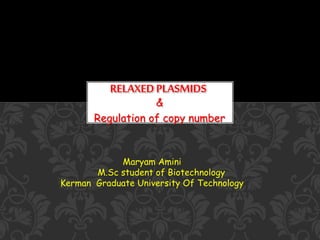
Relaxed plasmids & Regulation of copy number
- 1. & Regulation of copy number RELAXEDPLASMIDS Maryam Amini M.Sc student of Biotechnology Kerman Graduate University Of Technology
- 2. Based upon the number of copies per cell, plasmids are classified into two types. 1. Stringent plasmids These plasmids exist in small numbers, i.e. <100 copies/cell. Stringent plasmid is under the control of bacterial genome for replication and segregation. Generally, conjungtive plasmids are mostly stringent plasmids 2. Relaxed plasmids These plasmids exist in large numbers, i.e., > 100 copies/cell. Relaxed plasmid is not under the control of bacterial genome for replication and segregation. Generally, relaxed plasmids are of low molecular weight and most of them are of the non conjugative type. CLASSIFICATION OF PLASMIDS
- 3. The ability of certain plasmids to continue to replicate after their bacteria stop dividing, the result is a single bacteria that contains hundreds of plasmids. A plasmid that replicates independently of the main bacterial chromosome and is present in 10-500 copies per cell The plasmids used in molecular cloning, however, are under relaxed control; they are normally present in 10 to as many as 700 copies per cell. Moreover, protein synthesis in the bacterial host is inhibited, for example, by the antibiotic chloramphenicol, thereby preventing cell division. These plasmids continue to replicate until two or three thousand copies have accumulated per cell. The plasmids that have been constructed for molecular cloning are relatively small, replicate under relaxed control, carry genes specifying resistance to one or more antibiotics, and contain a number of conveniently located restriction endonuclease sites into which the DNA to be cloned may be inserted.
- 4. Stringent and Relaxed Plasmids - Plasmid SC101, and its derivatives are called stringent plasmids, while Co1E1 and its derivatives are relaxed plasmids with respect to DNA replication the differences between the two are as follows: pSC101 (Stringent) Co1E1 (relaxed) 1.Exponentially growing cells have 6- 8 plasmids per choromosome. Exponentially growing cellls have 20- 30 plasmids. 2.Plasmid replication requires new protein synthesis. No new protein synthesis required. 3.Plasmid replication does not require an active DNA polymerase I. Active DNA polymerase I required.
- 5. REGULATION OF COPY NUMBER ColE1 plasmids: • Many of the most popular lab plasmids were derived from ColE1 or pMB1, which is very similar; eg. pBR322, pUC series,pBAD series, pACYC184 and the pET series. • ColE1 plasmids use an antisense RNA called RNA I that interferes with processing of RNA II to the form that serves a primer to initiate replication by Pol I. • The more copies of the plasmid, the higher the concentration of RNA I to inhibit replication. • RNA I and RNA II are transcribed from the same region of DNA but in opposite directions using different, complementary template strands. • Binding of RNA I to RNA II prevents it from binding to OriV being processed to its primer form by RNase H. • The protein Rop stabilizes the interaction between RNAs I and II. • Note that no plasmid-encoded protein is necessary for replication.
- 8. Unilike ColEI, most plasmids require a plasmid encoded protein, called Rep, that separates the two strands of DNA at OriV to initiate replication. R1 plamids: • R1 plasmids use an antisense RNA to inhibit synthesis of Rep protein, which is necessary for replication. • The antisense RNA binds to and inhibits translation of an upstream orf to which the Rep gene is translationally coupled. • The concentration of antisense RNA in the cell reflects the plasimd copy number. If the number of plasmids falls below the copy number, the lower antisense RNA concentration allows Rep to be translated and replication results.
- 10. • plasmids such as RK2, F and R6K use a protein called RepA, which is necessary for replication, to regulate copy number in two ways. • First, RepA negatively autoregulates its own transcription. The more copies of a plasmid in the cell, the more RepA transcription in repressed. • Second, when a plasmid is in multicopy, RepA binds two of them together, which prevents replication instead of initiating it, as is the case when only one plasmid is bound. • This method is used by some stringent plasmids.
- 12. References: 1. http://www.molecular-plant-biotechnology.info/bacterial-vectors/classification-of-plasmids.htm 2. www.mondofacto.com/facts/dictionary?relaxed+plasmid 3. http://www.thefreedictionary.com/relaxed+plasmid 4. Principles of gene manipulation and genomics/ By S. B. Primrose, Richard M. Twyman/chapter4/basic biology of plasmid and phage vector/64-68 5. Voet, D. and Voet, J. G. Biochemistry John Wiley and Sons,Inc. New York, 1995. 6. Sarah Jandle and Richard Meyer,2006,Stringent and Relaxed Recognition of oriT by Related Systems for Plasmid Mobilization: Implications for Horizontal Gene Transfer, JOURNAL OF BACTERIOLOGY, 499–506 Vol. 188, No. 2, American Society for Microbiology.